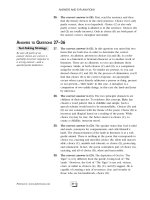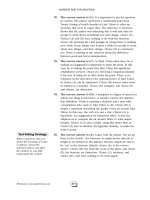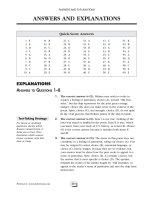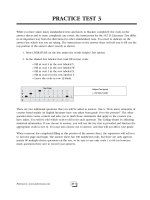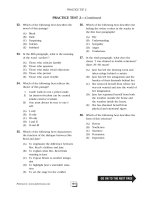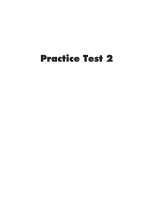SAT II success literature Episode 1 Part 7 docx
Bạn đang xem bản rút gọn của tài liệu. Xem và tải ngay bản đầy đủ của tài liệu tại đây (95.13 KB, 20 trang )
PRACTICING
Read the poem “Sonnet 29” by William Shakespeare. Jot down in the
margin or on a separate sheet of paper the answers to the questions.
In choosing your answers, apply the suggestions and strategies you
have just learned.
If you do not understand a question, check the explanation
immediately. You may refer to the answers question by question, or
you may wish to score the entire section at one time. No matter
which method you choose, read all the explanations. The reasoning
involved may point out concepts or details that you missed, and the
explanations will show you how the strategies can work for you. This
poem is not easy, so you may not be able to answer every question
correctly. That is why it is good practice.
CHAPTER 3: ELEMENTS OF POETRY
111Peterson’s: www.petersons.com
Directions: This test consists of selections of literature and
questions on their content, style, and form. After you have read
each passage, choose the answer that best answers the question
and fill in the appropriate oval on the answer sheet.
Note: Read each question carefully, paying particular attention
to those that contain the words not, least, or except.
Questions 1–12 refer to the following poem. Read the selection
carefully and then answer the questions.
Sonnet 29
Line When in disgrace with fortune and men’s eyes,
I all alone beweep my outcast state,
And trouble deaf heaven with my bootless cries,
And look upon myself and curse my fate,
Wishing me like to one more rich in hope,
Featured like him, like him with friends possessed,
Desiring this man’s art, and that man’s scope,
With what I most enjoy contented least.
Yet in these thoughts myself almost despising,
Haply I think on thee, and then my state,
Like to the lark at break of day arising
From sullen earth, sings hymns at heaven’s gate;
For thy sweet love remembered such wealth brings
That then I scorn to change my state with kings.
—William Shakespeare
1. What is the theme of this poem?
(A) The misfortunes that plague everyone
(B) The beauty of a new morning
(C) How the thought of the speaker’s
beloved can change one’s mood
(D) The speaker’s envy of other peoples’
lives
(E) The resentment that heaven has given
the speaker a poor lot in life
2. Which of the following choices best
describes the mood of lines 1 through 8?
(A) Joy
(B) Anger
(C) Resignation
(D) Frustration
(E) Self-pity
3. What is the tone of the last six lines?
(A) Despair
(B) Elation
(C) Heartache
(D) Confidence
(E) Calmness
SAT II SUCCESS: LITERATURE
5
10
112 Peterson’s SAT II Success: Literature
4. The first two quatrains express distinct but
related thoughts. What are they?
(A) The first quatrain expresses the
speaker’s extreme dissatisfaction with
himself, and the second expresses
envy of others’ happier lives.
(B) The first quatrain expresses the
speaker’s dissatisfaction, and the
second presents a solution.
(C) The first quatrain shows that the
speaker is very religious, and the
second expresses his contentment
with life.
(D) The first quatrain shows how envious
of others the speaker is, and the
second, his love of nature and beauty.
(E) The first quatrain speaks of his
dissatisfaction and envy, and the
second tells of his beloved.
5. What is the meaning of the phrase “trouble
deaf heaven” in line 3?
(A) The heavens are in turmoil.
(B) People are deaf to the will of God.
(C) God’s will falls on deaf ears.
(D) Troubled times are not heard in
heaven.
(E) One prays, but God does not hear.
6. Which lines summarize the theme of the
sonnet?
(A) The final couplet
(B) The first quatrain
(C) The second quatrain
(D) Lines 10 through 12
(E) Lines 2 through 8
7. What does the poet mean when he writes
“that man’s scope”?
(A) The man has made a profit in
business.
(B) By chance, the man has made a
fortune.
(C) The man is strong and handsome.
(D) The man is very intelligent.
(E) The man owns a rare astronomical
instrument.
8. The comparison of the speaker to a lark
(lines 11–12) is appropriate because a lark
(A) flies upward the way the speaker’s
mood improves.
(B) rises up to heaven.
(C) is fragile like a person’s ego.
(D) is a symbol of goodwill.
(E) sings its song as it sees the new day
break.
9. In lines 4 through 7, the speaker explains
that he envies all of the following aspects
of others EXCEPT
(A) hopefulness.
(B) having many friends.
(C) skill as an artist.
(D) a handsome appearance.
(E) contentment.
10. Which of the following best summarizes
the meaning of the first line of the sonnet?
(A) It is a time of good luck in dealing
with other people.
(B) It is a time of despair.
(C) It is a time of change.
(D) It is a time when everyone is watch-
ing what the speaker is doing.
(E) It is a time of sorrow because the
speaker’s wealth is gone.
CHAPTER 3: ELEMENTS OF POETRY
113Peterson’s: www.petersons.com
Quick-Score Answers
1. C
2. E
3. B
4. A
5. E
6. A
7. D
8. A
9. C
10. B
ANSWERS AND EXPLANATIONS
Test-Taking Strategy
Go back and check the
passage. Don’t rely on what
you think its says.
1. The correct answer is (C). In the first line of the poem,
Shakespeare identifies a character who is out of luck and not
well respected by his peers. In line 10, the poet introduces the
one individual who can bring joy to the life of the speaker. The
speaker can experience this emotional change through the mere
thought of the beloved. None of the other ideas fits the senti-
ment or the content of the poem. The speaker is neither
resentful, choice (E), nor envious, choice (D). The poem is not
about the morning, choice (B), nor other people’s misfortunes,
choice (A).
2. The correct answer is (E). The first eight lines of the sonnet
delineate all the negative things that the speaker has experi-
enced or feels. He feels, for example, that he has appealed for
help, and no one has responded. His list of negative feelings
about himself shows self-pity, choice (E), rather than passive
submission, choice (C). There is no expression of great anger at
his circumstances, choice (B), nor of having been thwarted,
choice (D). The feeling is more one of whining, choice (E).
Choice (A), joy, is found in the final six lines
3. The correct answer is (B). In contrast with the first eight
lines, the last six lines are uplifting. Shakespeare has his charac-
ter express his joy at the thought of thinking about his beloved.
The tone is the opposite of despair, choice (A), and heartache,
choice (C), and neither confidence, choice (D), nor calmness,
choice (E), is an accurate description of the speaker’s positive
feeling.
SAT II SUCCESS: LITERATURE
114 Peterson’s SAT II Success: Literature
Test-Taking Strategy
Both parts of an answer
must be correct. A partially
correct answer is a partially
incorrect answer—and a
quarter-point deduction.
4. The correct answer is (A). The second line of the first
quatrain makes a clear reference to the speaker’s view of
himself. He pities himself because he believes no one cares
about him. The first line of the second quatrain shifts to his view
of others. Choice (B) may seem as though it might be correct,
but it misreads the second quatrain. In addition, the word
desiring (line 7) is a clue to the speaker’s attitude in this
quatrain, and envy, choice (A), is a more accurate answer than
dissatisfaction, choice (B). Choice (C) does not reflect the
content nor does choice (D). You might be fooled into selecting
choice (E) unless you check the poem before answering. The
beloved is not in these eight lines.
5. The correct answer is (E). The word deaf is the key to this
answer. Shakespeare’s speaker is lamenting the fact that his cries
are falling on deaf ears in heaven. He is praying, but God is not
listening to him. This is another example of self-pity. Choices
(A), (B), and (D) do not reflect the content of the sonnet.
Heaven (God) is the one being appealed to, not the one giving
directions, so choice (C) is wrong.
Test-Taking Strategy
When several of the answers
seem to be correct, see if one
may be the main idea, or
theme, and the others,
supporting details.
6. The correct answer is (A). This question points out the
importance of checking the consistency among questions and
answers. The answer to question 1 should have helped you in
answering this question. The final couplet tells the reader that
no matter how bad things have been for the speaker, because of
his beloved, he would not trade his position for a king’s. The
first and second quatrains, choices (B) and (C), only list the
speaker’s problems. The other line possibilities, choices (D) and
(E), are only parts of the theme—supporting details.
7. The correct answer is (D). This phrase is contained in the
second quatrain where Shakespeare has the speaker enumerating
the qualities that others have that the speaker would like to
have. This eliminates choice (E) because it refers to an object.
The word scope is better associated with a person’s mind than
his fortune, choices (A) and (B), or appearance, choice (C). That
makes the correct answer choice (D). Choices (A) and (B) could
confuse you because the only difference in the idea is the phrase
by chance in choice (B).
ANSWERS AND EXPLANATIONS
115Peterson’s: www.petersons.com
8. The correct answer is (A). Shakespeare wants to create an
exhilarating mood. The lark provides that vehicle because, as a
bird, its flight toward heaven is uplifting. In addition, the lark
has a beautiful song, a characteristic that in literature elicits joy
in the hearer. Choices (B) and (E) are only partially correct.
They are in a sense supporting details that help to create the
overall image of the lark in the sonnet. Neither choice (C) nor
choice (D) is an accurate reading of the content.
Test-Taking Strategy
For not/except questions, ask
yourself if the answer is true
in the context of the ques-
tion. If it is, cross it off and
go on to the next answer.
9. The correct answer is (C). This question is best approached
by eliminating all the right answers. Check each phrase to see if
it is in the quatrain: hopefulness = “rich in hope,” choice (A);
many friends = “like him with friends possessed,” choice (B);
handsome appearance = “featured like him,” choice (D); and
intellectual ability = “that man’s scope,” choice (E). The phrase
that is not in the quatrain is choice (C), skill as an artist, which
is the correct response.
10. The correct answer is (B). The line has a negative feeling
because of the word disgrace; therefore, any answer such as
choices (A), (C), or (D) with a positive or neutral connotation
should be eliminated. Of the remaining two answers, choice (B)
reflects the sense of the expression “disgrace with fortune [read
as luck, not wealth] and men’s eyes.” Choice (E) takes a literal
reading of the line as wealth, and is, therefore, incorrect.
Remember in answering contextual meaning questions to
consider the connotation of a word or phrase, that is, the idea
or concept associated with or suggested by the word or phrase.
SAT II SUCCESS: LITERATURE
116 Peterson’s SAT II Success: Literature
Chapter 4
A QUICK REVIEW OF LITERARY TERMS
You will find a few questions on the test that give you an example
and ask you to identify what it is an example of. As you study for the
SAT II: Literature Test, review the terms in the following list. As you
read your assignments in English class, keep these concepts in mind.
Do not memorize the following list, but as you read novels, poems,
plays, short stories, and essays, see if you can pick out examples of
different ones.
accent: the stressed portion of a word
allegory: an extended narrative in prose or verse in which charac-
ters, events, and settings represent abstract qualities and in which the
writer intends a second meaning to be read beneath the surface story;
the underlying meaning may be moral, religious, political, social, or
satiric
alliteration: the repetition of consonant sounds at the beginning of
words that are close to one another; for example, “beautiful blossoms
blooming between the bushes”
allusion: a reference to another work or famous figure assumed to
be well known enough to be recognized by the reader
anachronism: an event, object, custom, person, or thing that is out
of order in time; some anachronisms are unintentional, such as when
an actor performing Shakespeare forgets to take off his watch; others
are deliberately used to achieve a humorous or satiric effect, such as
the sustained anachronism of Mark Twain’s A Connecticut Yankee in
King Arthur’s Court
analogy: a comparison of two similar but different things, usually to
clarify an action or a relationship, such as comparing the work of a
heart to that of a pump
anaphora: specific type of repetition; word, phrase, or clause
repeated at the beginning of two or more sentences in a row
anecdote: a short, simple narrative of an incident
aphorism: a short, often witty statement of a principle or a truth
about life
117Peterson’s: www.petersons.com
apostrophe: usually in poetry (not grammar, but sometimes in
prose), the device of calling out to an imaginary, dead, or absent
person or to a place, thing, or personified abstraction either to begin
a poem or to make a dramatic break in thought somewhere within
the poem
argumentation: writing that attempts to prove the validity of a point
of view or an idea by presenting reasoned arguments; persuasive
writing is a form of argumentation
aside: a brief speech or comment that an actor makes to the audi-
ence, supposedly without being heard by the other actors on stage;
often used for melodramatic or comedic effect
assonance: the repetition of vowel sounds between different
consonants, such as in neigh/fade
authority: support for an argument that is based on recognized
experts in the field
ballad: a long narrative poem that presents a single dramatic episode,
which is often tragic or violent; the two types of ballads are:
• folk ballad: one of the earliest forms of literature, a folk
ballad was usually sung and was passed down orally from
singer to singer; its author (if a single author) is generally
unknown, and its form and melody often changed according
to a singer’s preference
• literary ballad: also called an art ballad, this is a ballad that
imitates the form and spirit of the folk ballad but is more
polished and uses a higher level of poetic diction
blank verse: poetry written in unrhymed iambic pentameter, a
favorite form of Shakespeare
burlesque: broad parody; whereas a parody will imitate and exagger-
ate a specific work, such as Romeo and Juliet, a burlesque will take
an entire style or form, such as pastoral poetry, and exaggerate it into
ridiculousness
cacophony: harsh, awkward, or dissonant sounds used deliberately
in poetry or prose; the opposite of euphony
caricature: descriptive writing that greatly exaggerates a specific
feature of appearance or a facet of personality
catharsis: the emotional release that an audience member experi-
ences as a result of watching a tragedy
SAT II SUCCESS: LITERATURE
118 Peterson’s SAT II Success: Literature
chorus: in Greek drama, a group of characters who comments on
the action taking place on stage
classicism: the principles and styles admired in the classics of Greek
and Roman literature, such as objectivity, sensibility, restraint, and
formality
colloquialism: a word or phrase used in everyday conversation and
informal writing, but that is sometimes inappropriate in formal writing
conceit: an elaborate figure of speech in which two seemingly
dissimilar things or situations are compared
connotation: implied or suggested meaning of a word because of an
association in the reader’s mind
consonance: the repetition of identical consonant sounds before and
after different vowel sounds, as in boost/best; can also be seen within
several compound words, such as fulfill and Ping-Pong
conundrum: a riddle whose answer is or involves a pun; may also
be a paradox or difficult problem
denotation: literal meaning of a word as defined
description: the picturing in words of something or someone
through detailed observation of color, motion, sound, taste, smell,
and touch; one of the four modes of discourse
diction: word choice
discourse: spoken or written language, including literary works; the
four traditionally classified modes of discourse are description,
exposition, narration, and persuasion
dissonance: the grating of sounds that are harsh or do not go
together
elegy: a formal poem focusing on death or mortality, usually begin-
ning with the recent death of a particular person
end rhyme: a rhyme that comes at the end of lines of poetry; for
example:
Her voice, soft and lovely when she sings,
Came to me last night in a dream.
In my head her voice still rings,
How pleasant last night must seem.
CHAPTER 4: A QUICK REVIEW OF LITERARY TERMS
119Peterson’s: www.petersons.com
epic: a long narrative poem about a serious or profound subject in a
dignified style; usually featuring heroic characters and deeds impor-
tant in legends, two famous examples include the Iliad and the
Odyssey, both written by the Greek poet Homer
epigram: a concise, witty saying in poetry or prose that either stands
alone or is part of a larger work; may also refer to a short poem of
this type
euphony: a succession of harmonious sounds used in poetry or
prose; the opposite of cacophony
exemplum: a brief tale used in medieval times to illustrate a sermon
or teach a lesson
exposition: the immediate revelation to the audience of the setting
and other background information necessary for understanding the
plot; also, explanation; one of the four modes of discourse
expressive: another name for descriptive writing
farce: a light, dramatic composition characterized by broad satirical
comedy and a highly improbable plot
figurative language: language that contains figures of speech such
as similes and metaphors in order to create associations that are
imaginative rather than literal; also figures of sound
figures of sound: expressions that create aural images
figures of speech: expressions such as similes, metaphors, and
personifications that make imaginative, rather than literal, compari-
sons or associations
foil: a character who, by contrast, highlights the characteristics of
another character
folklore: traditional stories, songs, dances, and customs that are
preserved among a people; folklore usually precedes literature, being
passed down orally between generations until recorded by scholars
SAT II SUCCESS: LITERATURE
120 Peterson’s SAT II Success: Literature
foot: the combination of stressed and unstressed syllables that makes
up the basic rhythmic unit of a line of poetry; common poetic feet
include:
• anapest: two unstressed followed by one stressed syllable, as
in in-ter-rupt
• dactyl: one stressed followed by two unstressed syllables, as
in beau-ti-ful
• iamb: one unstressed followed by one stressed syllable, as in
dis-turb
• spondee: two successive stressed syllables, as in hodge-podge
• trochee: one stressed followed by one unstressed syllable, as
in in-jure and con-stant
foreshadowing: the use of a hint or clue to suggest a larger event
that occurs later in the work
free verse: poetry that is written without a regular meter, usually
without rhyme
genre: a type of literary work, such as a novel or poem; there are
also subgenres, such as science fiction novel and sonnet, within the
larger genres
gothic: referring to a type of novel that emerged in the eighteenth
century that uses mystery, suspense, and sensational and supernatural
occurrences to evoke terror
hubris: the excessive pride or ambition that leads a tragic hero to
disregard warnings of impending doom, eventually causing his or her
downfall
humor: anything that causes laughter or amusement; up until the
end of the Renaissance, humor meant a person’s temperament
hyperbole: deliberate exaggeration in order to create humor or
emphasis; overstatement
idyll: a short descriptive narrative, usually a poem, about an idealized
country life; also called a pastoral
imagery: words or phrases that use a collection of images to appeal
to one or more of the five senses in order to create a mental picture
infor mative: another name for expository writing
interior monologue: writing that records the talking that occurs
inside a character’s head
CHAPTER 4: A QUICK REVIEW OF LITERARY TERMS
121Peterson’s: www.petersons.com
internal rhyme: a rhyme occurring within a line of poetry, as in
Edgar Allan Poe’s “The Raven”:
Once upon a midnight dreary, while I pondered weak and weary,
Over many a quaint and curious volume of forgotten lore,
While I nodded, nearly napping, suddenly there came a tapping,
As of someone gently rapping, rapping at my chamber door.
inversion: reversing the customary order of elements in a sentence
or phrase; used effectively in many cases, such as posing a question:
“Are you going to the store?”; often used ineffectively in poetry,
making it look artificial and stilted: “To the hounds she rode, with her
flags behind her streaming”
irony: a situation or statement in which the actual outcome or
meaning is opposite to what was expected
loose sentence: a sentence that is grammatically complete before its
end, such as “Thalia played the violin with an intensity never before
seen in a high school music class”; the sentence is grammatically
complete after the word violin
lyric: a type of melodious, imaginative, and subjective poetry that is
usually short and personal, expressing the thoughts and feelings of a
single speaker rather than telling a story
maxim: statement of a general truth
metaphor: a figure of speech in which one thing is referred to as
another; for example, “my love is a fragile flower”
meter: the repetition of a regular rhythmic unit in a line of poetry;
meters found in poetry include:
• monometer: one foot (rare)
• dimeter: two feet (rare)
• trimeter: three feet
• tetrameter: four feet
• pentameter: five feet
• hexameter: six feet
• heptameter: seven feet (rare)
metonymy: a figure of speech that uses the name of an object,
person, or idea to represent something with which it is associated,
such as using “the crown” to refer to a monarch
SAT II SUCCESS: LITERATURE
122 Peterson’s SAT II Success: Literature
mode: the method or form of a literary work; a manner in which a
work of literature is written
mood: similar to tone, mood is the primary emotional attitude of a
work
motif: main theme or subject of a work that is elaborated on in the
development of the piece; a repeated pattern or idea
myth: one story in a system of narratives set in a complete imaginary
world that once served to explain the origin of life, religious beliefs,
and the forces of nature as supernatural occurrences
narration: the telling of a story in fiction, nonfiction, poetry, or
drama; one of the four modes of discourse
naturalism: a literary movement that grew out of realism in France,
the United States, and England in the late nineteenth and early
twentieth centuries; it portrays humans as having no free will, being
driven by the natural forces of heredity, environment, and animalistic
urges over which they have no control
objectivity: an impersonal presentation of events and characters
ode: a long lyric poem, usually serious and elevated in tone; often
written to praise someone or something
onomatopoeia: the use of words that sound like what they mean,
such as hiss and boom
order of development: the way in which ideas are organized in
writing an essay
• chronological order: information arranged in time sequence
• spatial order: information arranged according to space
relationships
• order of importance: information arranged from least
important to most important, or vice versa
• compare and contrast: information arranged according to
similarities and differences between two or more subjects
• developmental order: information arranged so that one
point leads logically to another
• deductive order: information arranged from general to the
specific
• inductive order: information arranged from specific to
general
CHAPTER 4: A QUICK REVIEW OF LITERARY TERMS
123Peterson’s: www.petersons.com
overstatement: exaggerated for humorous effect; hyperbole
oxymoron: a figure of speech composed of contradictory words or
phrases, such as “wise fool”
parable: a short tale that teaches a moral; similar to but shorter than
an allegory
paradox: a statement that seems to contradict itself but that turns
out to have a rational meaning, as in this quotation from Henry David
Thoreau: “I never found the companion that was so companionable
as solitude.”
parallelism: the technique of arranging words, phrases, clauses, or
larger structures by placing them side by side and making them
similar in form
parody: a work that ridicules the style of another work by imitating
and exaggerating its elements
pastoral: a poem about idealized rural life, or shepherds, or both;
also called an idyll
periodic sentence: a sentence that is not grammatically complete
until its last phrase, such as, “Despite Glenn’s hatred of his sister’s
laziness and noisy eating habits, he still cared for her.”
persona: a fictional voice that a writer adopts to tell a story, deter-
mined by subject matter and audience; e.g., Mark Twain
personification: the attribution of human qualities to a nonhuman
or an inanimate object
persuasion: one of the four modes of discourse; language intended
to convince through appeals to reason or emotion; also called
argument
Petrarchan sonnet: one of the most important types of sonnets,
composed of an octave with an abba abba rhyme scheme, and
ending in a sestet with a cde cde rhyme scheme; also called an Italian
sonnet
SAT II SUCCESS: LITERATURE
124 Peterson’s SAT II Success: Literature
point of view: the perspective from which a story is presented;
common points of view include:
• first person narrator: a narrator, referred to as “I,” who is a
character in the story and relates the actions through his or
her perspective, also revealing his or her own thoughts
• stream of consciousness narrator: like a first person
narrator, but instead placing the reader inside the character’s
head, making the reader privy to the continuous, chaotic flow
of disconnected, half-formed thoughts and impressions as they
flow through the character’s consciousness
• omniscient narrator: a third person narrator, referred to as
“he,” “she,” or “they,” who is able to see into each character’s
mind and understands all the action
• limited omniscient narrator: a third person narrator who
only reports the thoughts of one character, and generally only
what that one character sees
• objective narrator: a third person narrator who only reports
what would be visible to a camera; thoughts and feelings are
only revealed if a character speaks of them
protagonist: the main character of a literary work
realism: a nineteenth-century literary movement in Europe and the
United States that stressed accuracy in the portrayal of life, focusing
on characters with whom middle-class readers could easily identify; in
direct contrast with romanticism
refrain: a line or group of lines that are periodically repeated
throughout a poem
regionalism: an element in literature that conveys a realistic
portrayal of a specific geographical locale, using the locale and its
influences as a major part of the plot
rhetoric: the art of using language effectively; involves (1) writer’s
purpose, (2) his or her consideration of the audience, (3) the
exploration of the subject, (4) arrangement and organization of the
ideas, (5) style and tone of expression, and (6) form
rhetorical modes: exposition, description, narration, argumen-
tation
CHAPTER 4: A QUICK REVIEW OF LITERARY TERMS
125Peterson’s: www.petersons.com
rhyme: a similarity of accented sounds between two words, such as
sad/mad; rhymes can be masculine or feminine:
• masculine: the rhyme sound is the last syllable of a line, i.e.
profound/bound
• feminine: the accented syllable is followed by an unaccented
syllable, i.e. banding/landing
romanticism: a literary, artistic, and philosophical movement that
began in the eighteenth century as a reaction against neoclassicism;
the focal points of the movement are imagination, emotion, and
freedom, stressing subjectivity, individuality, the love and worship of
nature, and a fascination with the past
sarcasm: harsh, caustic personal remarks to or about someone; less
subtle than irony
satire: work that attacks or ridicules human follies, stupidities, and
abuses
simile: a figure of speech that uses like, as, or as if to make a
direct comparison between two essentially different objects, actions,
or qualities; for example, “the sky looked like an artist’s canvas”
slant rhyme: close but not exact correspondence between sounds,
such as unit and mode
soliloquy: a speech spoken by a character alone on stage, giving the
impression that the audience is listening to the character’s thoughts;
perhaps the most famous example is Hamlet’s speech that begins “To
be, or not to be”
sonnet: a fourteen-line lyric poem in iambic pentameter
speaker: the voice of a poem; an author may speak as himself or
herself or as a fictitious character
sprung rhythm: based on normal rhythms of speech and using a
mixture of feet; each foot has either a single stressed syllable or a
stressed syllable followed by one or more unstressed syllables
SAT II SUCCESS: LITERATURE
126 Peterson’s SAT II Success: Literature
stanza: a group of lines in the formal pattern of a poem; types of
stanzas include:
• couplet: the simplest stanza, consisting of two rhymed lines
• tercet: three lines, usually having the same rhyme
• quatrain: four lines
• cinquain: five lines
• sestet: six lines
• octave: eight lines
stereotype: a character who represents a trait that is usually attrib-
uted to a particular social or racial group and lacks individuality
stock character: a standard character who may be stereotyped,
such as the miser or the fool, or universally recognized, like the
hard-boiled private eye in detective stories
style: an author’s characteristic manner of expression
subjectivity: a personal presentation of events and characters,
influenced by the author’s feelings and opinions
suspension of disbelief: the demand made of a theater audience to
provide some details with their imagination and to accept the
limitations of reality and staging; also, the acceptance of the incidents
of the plot by a reader or audience
symbolism: the use of symbols, or anything that is meant to be
taken both literally and as representative of a higher and more
complex significance
synecdoche: a figure of speech in which a part of something is
used to represent a whole, such as using “boards” to mean “a stage”
or “wheels” to mean “a car”
syntax: arrangement of words, phrases, clauses; sentence structure
theme: the central idea or “message” of a literary work
tone: the characteristic emotion or attitude of an author toward the
characters, subject, and audience
CHAPTER 4: A QUICK REVIEW OF LITERARY TERMS
127Peterson’s: www.petersons.com
tragic flaw: the one weakness that causes the downfall of the hero
in a tragedy
understatement: undervaluing of a thing or person
unity: quality of a piece of writing; see also coherence
villanelle: a lyric poem consisting of five tercets and a final quatrain
voice: the way a written work conveys an author’s attitude
SAT II SUCCESS: LITERATURE
128 Peterson’s SAT II Success: Literature
Chapter 5
A QUICK REVIEW OF USAGE
Any usage questions on the SAT II: Literature Test are really disguised
comprehension questions. A question may ask you to identify one of
the parts of speech—nouns, verbs, adjectives, adverbs, prepositions,
conjunctions, and interjections—or you may be asked to classify parts
of a sentence—subjects, predicates, complements, modifiers, or an
antecedent of a word. Remember that the sentences that are used as
the basis for questions will not be easy to understand. You may need
to pull them apart to find elements such as the main clause, the
subject of the subordinate clause, the main verb, or the direct or
indirect object. Here is a quick review to help you answer questions
like these.
FUNCTIONS OF NOUNS AND PRONOUNS
• For the subject, look for nouns, pronouns, or word groups (ger-
unds, participial phrases, or clauses) acting as essential nouns that
tell you who or what the sentence is about.
What I have described in the Frenchman was merely the
result of an excited, or perhaps of a diseased, intelligence.
—“The Murders in the Rue Morgue,”
Edgar Allen Poe
Note: The subject will not be stated if the sentence or clause is
imperative.
“Do talk to me as if I were one,” said Lord Warburton.
—Portrait of a Lady,
Henry James
• A gerund is a verb that ends in -ing and serves as a noun. It may
take objects, complements, and modifiers.
Describing the Frenchman was a tour de force for Poe.
129Peterson’s: www.petersons.com
• A participle is a verb that ends in either -ing or -ed and modifies a
noun or pronoun. A participle in a participial phrase may have
objects, complements, and modifiers of its own.
What I have described in the Frenchman was merely the result
of an excited, or perhaps of a diseased, intelligence.
—“The Murders in the Rue Morgue,”
Edgar Allen Poe
• The direct object is a noun, pronoun, or group of words acting as a
noun that receives the action of a transitive verb, the person or
thing acted on. To find a direct object, rephrase the sentence by
changing it into a whom or what question.
I believe that I have omitted mentioning that in my first
voyage from Boston to Philadelphia, being becalmed off Block
Island, our crew employed themselves catching cod and
hauled up a great number.
—Autobiography of Benjamin Franklin,
Benjamin Franklin
Rephrased: I have omitted whom or what? The direct object is
mentioning.
• An indirect object is a noun or pronoun that appears with a direct
object and names the person or thing that something is given to or
done for.
Whichever way I turn, O I think you could give me my mate
back again if you only would.
—“Sea-Drift,” Walt Whitman
• A sentence can have both an object and an indirect object.
Whichever way I turn, O I think you could give me my mate
back again if you only would.
—“Sea-Drift,” Walt Whitman
• An antecedent is a noun or words taking the place of nouns for
which a pronoun stands.
No good novel will ever proceed from a superficial mind; that
seems to me an axiom which, for the artist in fiction, will
cover all needful moral ground: if the youthful aspirant take it
to heart it will illuminate for him many of the mysteries of
“purpose.”
—“The Art of Fiction,” Henry James
SAT II SUCCESS: LITERATURE
130 Peterson’s SAT II Success: Literature


